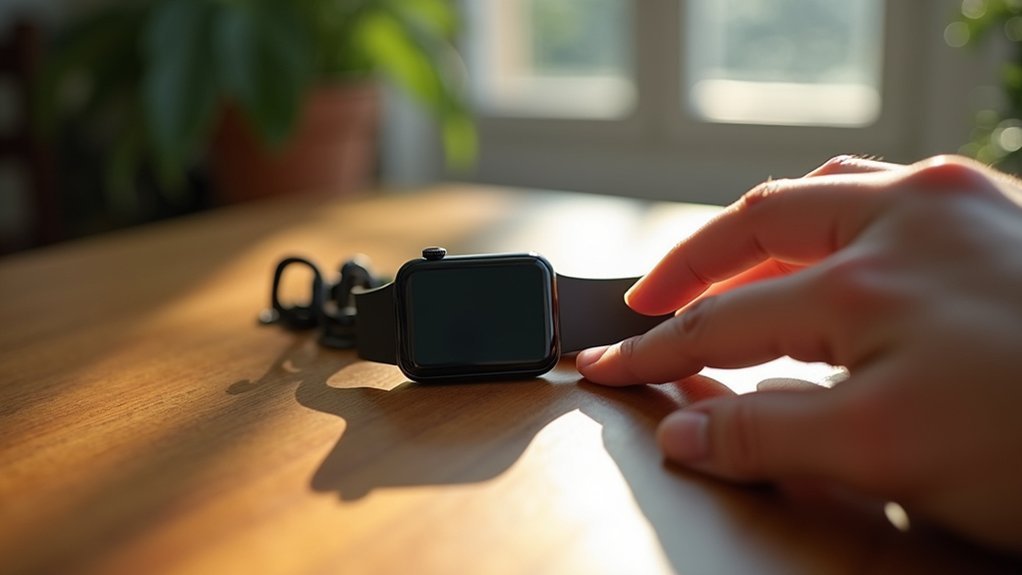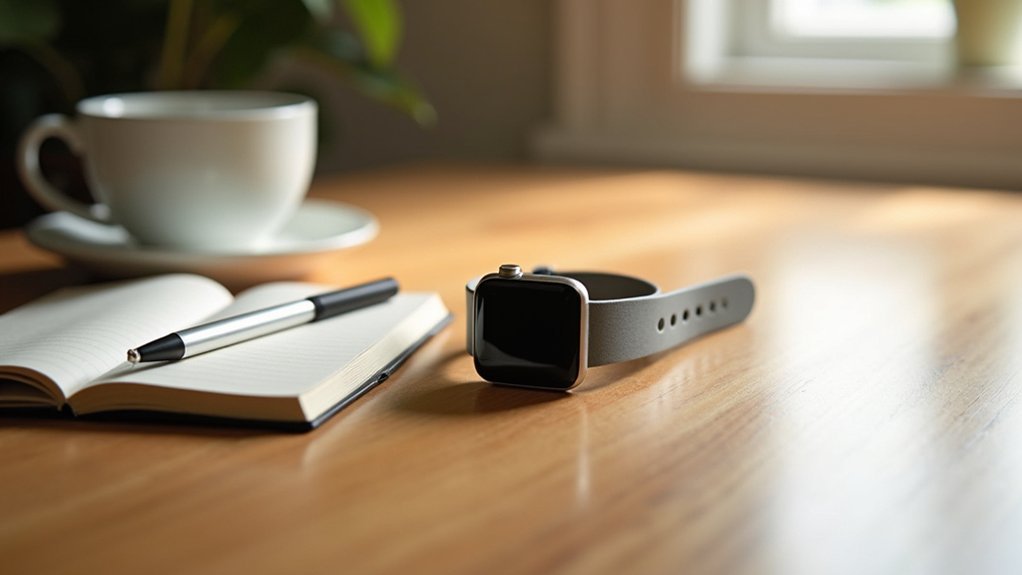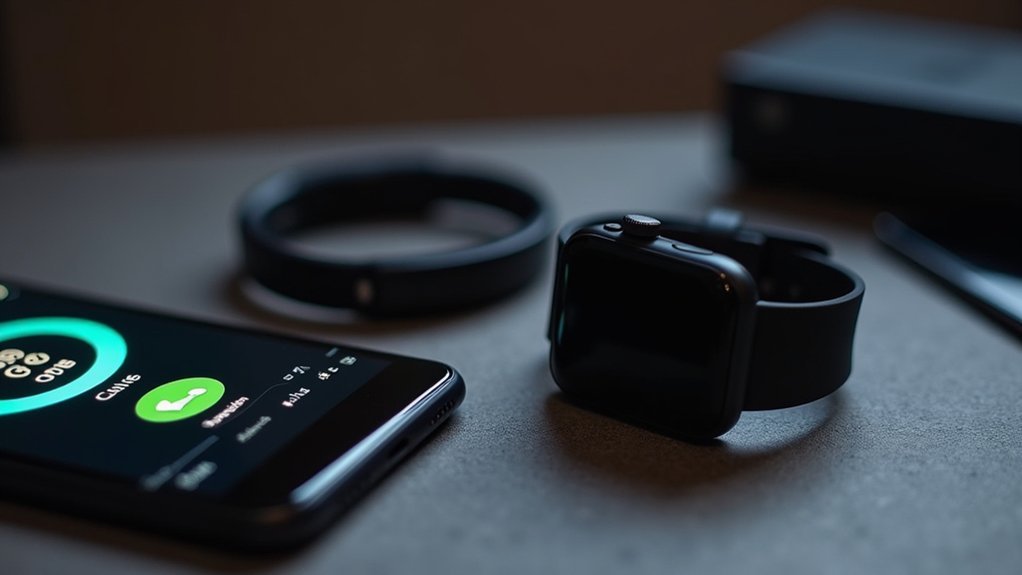To set up important calls only mode on your wearable device, access the Do Not Disturb settings by swiping down from your watch face and tapping the DND icon. Configure priority contacts through your device’s settings menu, designating specific contacts or favorites who can bypass the filter. You can also schedule automatic activation for meetings, sleep, or workout times. This feature blocks distracting notifications while ensuring emergency contacts reach you. Proper configuration releases additional customization options for ideal call management.
Understanding Important Calls Only Mode for Wearable Devices

When you’re juggling multiple notifications throughout the day, Important Calls Only Mode serves as a strategic filter that allows only your most critical communications to reach your wearable device.
This feature transforms your smartwatch or fitness tracker into a focused communication tool that blocks distracting notifications while maintaining access to emergency contacts and priority calls.
You’ll find this mode particularly valuable during meetings, workouts, or sleep when you can’t afford interruptions but need to stay reachable for urgent situations.
The system works by filtering incoming communications through your preset contact lists or emergency protocols, ensuring you won’t miss critical calls from family members or work contacts while eliminating spam and non-essential notifications that typically clutter your device throughout the day. Most wearables rely on internet connectivity to sync these filtered notifications with your smartphone and other connected devices.
Configuring Do Not Disturb Settings on Android Smartwatches
To configure Do Not Disturb settings on your Android smartwatch, you’ll need to access the Quick Settings panel by swiping down from the watch face and tapping the DND icon.
Once you’ve activated DND, press and hold the icon to enter the deeper settings where you can customize which notifications get through.
This is where you’ll set up priority contacts and specify exceptions for important calls while silencing everything else. The intuitive design makes it easy to navigate through these settings and adjust your preferences quickly.
Accessing DND Settings
Before you can enable calls only mode, you’ll need to access your Android smartwatch’s Do Not Disturb settings through one of several available methods.
The quickest approach is swiping down from your screen’s top edge to open the Quick Settings panel. Look for the DND icon, typically displayed as a circle with a line or bell with a slash, then tap it once to toggle the mode. You can press and hold the icon to access additional configuration options and sleep mode settings.
For more detailed configuration options, navigate to your watch’s Settings app and locate “Modes,” “Sound & Notifications,” or “Do Not Disturb” sections.
Here you’ll find granular controls for scheduling, exceptions, and notification preferences that aren’t available through the quick toggle method.
Customizing Priority Contacts
Once you’ve accessed your DND settings, you’ll want to designate specific contacts who can still reach you during calls only mode.
Navigate to your priority contact settings and select “Starred contacts” or “Favorites” to automatically include your most important contacts. You can also manually add specific contacts to your priority list by selecting “Custom” and choosing individual contacts from your phone book.
Your Wear OS watch will sync these priority settings with your phone, ensuring consistent notifications across both devices. For devices running Android 11 or higher, you can also manage priority conversations through the dedicated notification settings section.
Priority contacts can bypass Do Not Disturb mode completely, so their calls will always come through even when your watch is in calls only mode.
You’ll also have the flexibility to customize notification sounds and vibration patterns specifically for these priority contacts.
Setting Up Focus Mode for Apple Watch Users

Apple Watch users can leverage Focus Mode to create a calls-only experience that filters out distracting notifications while keeping essential communication channels open.
You’ll find Focus Mode in your Apple Watch Settings – simply tap Focus to access available modes. Choose a pre-installed mode like Work or create a custom one by tapping the plus icon.
To use different Focus settings on your Apple Watch than your iPhone, disable “Mirror my iPhone” in the Focus settings. You can assign specific watch faces to each Focus mode through “Customize Screens” for a personalized experience.
Set duration preferences and activate modes through Control Center for quick access when you need uninterrupted focus time. You can also schedule automatic Focus Mode activation to ensure your calls-only mode turns on at specific times or locations.
Creating Priority Contact Lists for Wearable Notifications
Priority contact lists transform your wearable device into a focused communication tool by filtering which calls and messages deserve your immediate attention.
Transform your wearable into a focused communication hub by filtering only the calls and messages that truly matter.
You’ll minimize distractions from unimportant contacts while ensuring critical communications from selected individuals never get missed. Most wearables require companion apps for contact configuration, which sync seamlessly with your smartphone’s notification settings.
Here’s how to optimize your priority contact setup:
- Access notification settings through your phone’s Settings > Notifications > Conversations menu
- Add important contacts to your Priority conversations list with customized alert styles
- Enable real-time syncing between your wearable’s companion app and smartphone notifications
- Review and update your priority list regularly to maintain relevance and security
Your wearable will now mirror only the most important communications. Remember to sync the device after making any changes to ensure your new contact priority settings take effect properly.
Customizing Call Filtering Options on Fitness Trackers

While fitness trackers excel at monitoring your health metrics, they face significant limitations when it comes to call filtering compared to smartwatches or smartphones. Most fitness trackers lack built-in call filtering capabilities and rely entirely on your connected smartphone for call management.
You’ll need to work around these hardware and software constraints by leveraging smartphone integration. Install call filtering apps like “Call Filter” on your phone, which can indirectly manage notifications sent to your tracker. Some devices allow you to customize notification settings to filter out non-essential calls.
Consider carrier services like Verizon’s Call Filter for spam identification. Create customizable allow lists ensuring important calls reach you. Call Filter Free allows five allowed numbers while the Plus version accommodates ten for enhanced filtering control.
Cloud-based filtering services and AI-powered solutions represent future improvements for enhanced fitness tracker call management.
Syncing Important Calls Settings Between Phone and Wearable
Once you’ve established call filtering on your fitness tracker, guaranteeing seamless synchronization between your phone and wearable becomes essential for maintaining consistent call management.
Your devices need proper configuration to work together effectively.
Here’s how to sync your important calls settings:
- Enable Device Permissions – Grant necessary permissions through your phone’s companion app (like Galaxy Wearable) and guarantee Bluetooth remains active for continuous syncing.
- Configure Caller ID Settings – Keep privacy and caller identification settings consistent on both devices to prevent discrepancies when calls route through your wearable. When using NumberSync for wearables, outgoing calls from your smartwatch will display your smartphone number to recipients.
- Test Cellular Independence – Temporarily disable Bluetooth to verify your wearable can handle important calls independently when your phone’s in airplane mode.
- Verify Call Forwarding – Confirm incoming calls ring simultaneously on both devices, allowing you to answer from either device seamlessly.
Managing Third-Party App Notifications on Smart Devices
When you’re setting up calls only mode, you’ll need to configure your smart device’s third-party app notifications to prevent distractions.
Start by adjusting app priority settings to guarantee only essential communications can break through your focused state.
Next, configure notification filters to automatically block non-urgent alerts while still allowing important calls to reach you. Modern devices like macOS Monterey include notification focus modes that help streamline this process by automatically managing which notifications can interrupt your workflow.
App Priority Settings
Managing notifications effectively becomes essential as third-party apps compete for your attention throughout the day.
App priority settings let you control which notifications deserve immediate attention while filtering out less critical alerts. You can customize these preferences to guarantee important calls and messages aren’t buried beneath social media updates or promotional notifications.
Here’s how to optimize your app priority settings:
- Set High Priority Apps – Mark essential communication apps like phone, messaging, and work-related applications as high priority.
- Customize Notification Visibility – Configure high-priority notifications to appear at the top of your notification list and lock screen.
- Use Smart Prioritization – Enable automatic prioritization based on your interaction patterns with different apps. Priority mode utilizes do not disturb features to block all calls and notifications during active usage.
- Apply Enterprise Controls – Utilize MDM solutions for consistent priority settings across multiple devices in business environments.
Notification Filter Configuration
While app priority settings provide a foundation for managing notifications, notification filters offer granular control over which third-party applications can interrupt your workflow.
You can configure global settings to control notification behavior across all apps, then override these with application-specific preferences for individual apps that matter most.
Toggle notifications on or off for specific events or devices based on their importance to your daily routine.
For advanced management, you’ll find APIs like Alexa Notifications REST API useful for sending customized notifications from integrated smart home devices. Tools like BuzzKill allow you to create customizable notification experiences by filtering alerts based on specific phrases or app behaviors.
Use Do Not Disturb features to silence all notifications during focused work periods, while creating override exceptions for critical apps.
Silent notification options let important alerts appear without disruptive sounds or vibrations during calls-only mode.
Scheduling Automatic Important Calls Mode Activation
Since interruptions can derail your focus at the worst possible times, scheduling automatic Important Calls Only Mode activation lets you proactively filter communications without manual intervention.
You’ll maintain essential connectivity while eliminating distractions during critical periods.
Most smartphones and wearable devices support scheduling features that automatically enable this mode based on your preferences.
Modern devices offer built-in scheduling capabilities that automatically activate focus modes according to your personalized settings and daily routines.
Here’s how to set up automated activation:
- Set timed schedules – Create recurring time windows for daily meetings, focus work, or sleep hours
- Configure location-based triggers – Activate automatically when entering specific geofenced areas like your office or gym
- Integrate with calendar events – Link activation to scheduled meetings or appointments for seamless protection
- Define priority contact lists – Specify which contacts can bypass the filter during scheduled periods
This proactive approach guarantees you’re never caught off-guard by unnecessary interruptions.
For critical safety situations, emergency devices provide two-way communication capabilities that ensure help can reach you even when your phone is in filtered mode.
Testing and Troubleshooting Wearable Call Priority Settings
After configuring your wearable’s call priority settings, you’ll need to verify they’re working correctly across all your connected devices.
Start by testing multiple Bluetooth connections to confirm your most important device receives calls first. If you’re experiencing conflicts, reset your Bluetooth connections and adjust device priority through your platform’s app, whether it’s Garmin Connect or Samsung’s interface.
Monitor how your wearable handles overlapping connections and switches between devices during calls. Check that connection parameters are properly configured to manage simultaneous devices without dropping important connections.
Keep your firmware updated to resolve connectivity issues and improve call management performance. When using multiple Garmin devices, designate a primary wearable in your settings to ensure consistent data tracking and call handling across your connected ecosystem.
If problems persist, implement priority tables in your device settings and confirm audio output is correctly routed to your preferred device for seamless call handling.
Optimizing Battery Life While Using Selective Notification Features
Proper call priority configuration requires careful attention to power consumption, especially when you’re running selective notification features that constantly monitor incoming communications.
Your device’s battery life depends on how efficiently these background processes operate while filtering calls and notifications.
Efficient background processing while managing call and notification filtering directly impacts how long your wearable device stays powered throughout the day.
Smart optimization strategies can considerably extend your wearable’s runtime:
- Enable Low Power Modes – Configure your device to enter high impedance states between notification checks, reducing current leakage during inactive periods.
- Minimize Radio Activity – Batch notification data and reduce unnecessary wireless transmissions to conserve power.
- Use Selective Polling – Limit excessive sensor monitoring by adjusting notification frequency settings based on your actual usage patterns.
- Optimize Component Selection – Choose notification settings that utilize your device’s most efficient power management features and sleep modes.
During periods of minimal activity, activate ship mode functionality to place your device in an ultra-low power state that dramatically reduces background current consumption.
Maintaining and Updating Your Wearable’s Call Management System
Once you’ve configured your wearable’s call-only settings, regular maintenance guarantees your device continues filtering communications effectively.
Check for software updates regularly, as firmware improvements often enhance call detection accuracy and add new customization features. Apply security patches promptly to maintain reliable call filtering and keep companion mobile apps updated for seamless synchronization.
Maintain an up-to-date contact list by reviewing and adjusting permitted callers regularly. Use contact groups like family, healthcare providers, and work contacts for easier management.
Remove inactive contacts to minimize distractions and sync contacts across your wearable and smartphone consistently.
Monitor call logs to verify important calls reach you while others stay blocked. Use diagnostic tools to identify filtering issues and adjust sensitivity settings when needed.
Schedule periodic tests with important contacts to confirm your system’s functionality. Consider adding emergency contacts who can reach you immediately in case your wearable device requires urgent assistance or technical support.
Frequently Asked Questions
Can Important Calls Still Come Through When My Phone Is Completely Powered Off?
No, you can’t receive important calls when your phone’s completely powered off. Your device needs power to operate cellular components and run apps that filter calls, so all calls are blocked until you turn it back on.
Will Emergency Services Be Able to Reach Me During Important Calls Only Mode?
Emergency services can’t reach you during Important Calls Only mode since it restricts incoming calls. However, you can still make outgoing emergency calls to 911 or other emergency numbers without any restrictions.
How Do I Allow Calls From Unknown Numbers During Family Emergencies?
You can’t directly allow all unknown numbers on iOS during emergencies, but you’ll need to add specific emergency contacts to your Focus mode settings to bypass Do Not Disturb restrictions.
Does Important Calls Mode Work the Same Way Across Different Carriers?
Important Calls mode doesn’t work consistently across carriers. You’ll find different interfaces, terminology, and customization options with Verizon, AT&T, and T-Mobile. Each carrier implements call filtering features differently, creating inconsistent user experiences.
Can I Set Different Important Contact Lists for Weekdays Versus Weekends?
Android’s built-in Do Not Disturb doesn’t offer weekday/weekend contact lists. You’ll need third-party automation apps like Tasker or IFTTT to automatically switch between different priority contact lists based on specific days.





Leave a Reply